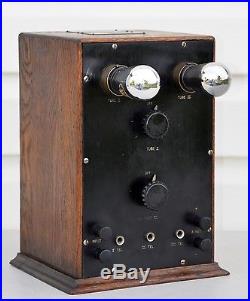
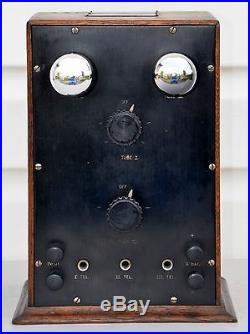

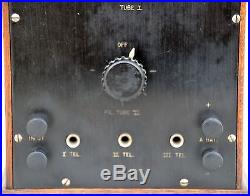
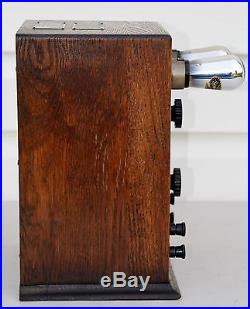
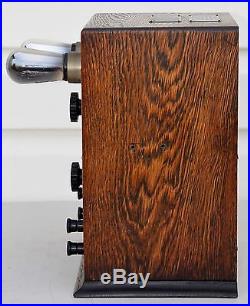
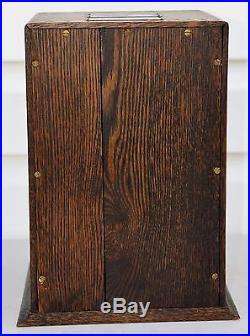
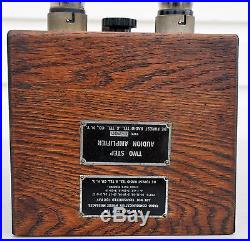
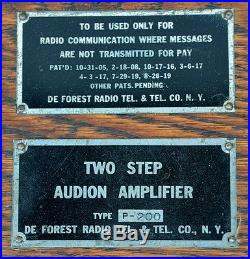

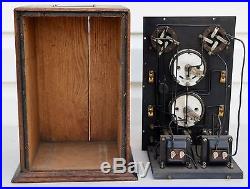
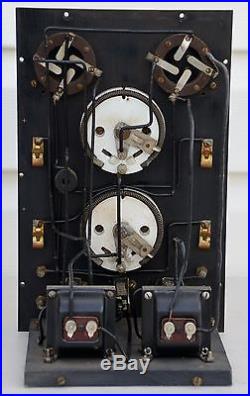
I found the following information from a copy of The William B. Duck Company, Catalog #15, Radio & Electrical Supplies, Page 35. P-200 Two-Step Amplifier without amplifying tubes and “A” battery. This is the very latest in amplifier design and will be found to be very different and so much more efficient than our older types of amplifiers that there is no comparison. The most notable feature of the new design is its compactness. The small case contains not only the amplifying coils, telephone jacks, amplifier tube receptacles, and filament resistances, but also a “B” battery of 40 volts which is sufficient to give amplifications up to 10,000 times. All these pieces of apparatus are mounted on the panel and come out with it. The panel is easily removable making all parts most accessible and the replacing of the “B” batteries but a moment’s work. Unit batteries of 20 volts each, cast in one block, are used. Those come provided with two leads which are connected to the circuit by means of two connecting clips. It is therefore unnecessary to use a soldering iron to connect together a number of cells. Moreover, the new type of battery is the most efficient and practical battery made. It has a remarkable shelf life and operating life of approximately 2000 hours when used with our type VT 21 tubes in this type of amplifier. Users of amplifiers in the past will appreciate this new development in “B” batteries which has taken place during the war. The panel is of 3/8 Bakelite beautifully engraved. The tube receptacles are nickel plated with a high polish and the knobs and binding posts are of bakelite. These are large in size and are of an expensive and artistic type. The binding posts are provided with slots to hold the wire in place while the head is being screwed down. The cabinet is of oak with “Early English” Finish. It is strongly built and beautifully polished. In order to operate the instrument it is only necessary to connect a six volt storage battery to the two binding posts marked A. The source of audio frequency should be connected to the two posts marked INPUT. ” If the plug on the telephone cord is then inserted in the jack marked “I. TEL, the audio frequency to which the device is connected will be received unamplified. If then the plug is inserted in the jack II. TEL” and the filament rheostat marked “FILAMENT. I is adjusted, the audio frequency will be amplified by means of the first step. If a similar operation performed with the rheostat for the second tube after the telephone plug is inserted in the jack marked III. TEL, the full amplifying power of the instrument will be obtained. Measurements: 12½” X 93/8″ X 73/4. Please be sure to check out our other auctions as we have several other EARLY DeForest pieces including a W5 radio w/ speaker and a W6 Speaker!! We have not tested it in any way. We can be reached at 317.340.6170. The item “VTG (1919) DeForest P-200 Two Step Audio Amplifier Marconia Era Radio” is in sale since Tuesday, June 21, 2016. This item is in the category “Collectibles\Radio, Phonograph, TV, Phone\Radios\Tube Radios\Pre-1930″. The seller is “2brosvintagestuff” and is located in Pittsboro, Indiana. This item can be shipped worldwide.